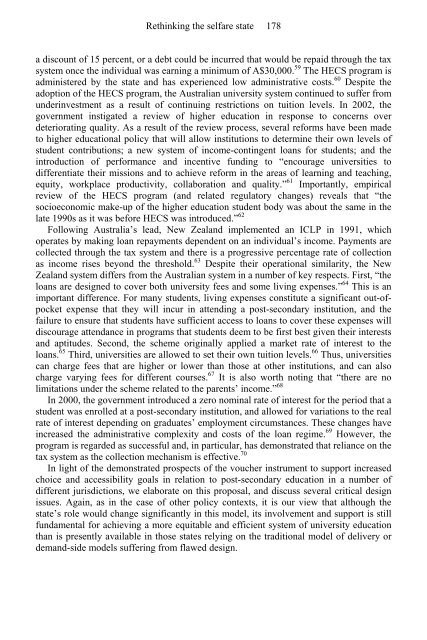Rethinking the Welfare State: The prospects for ... - e-Library
Rethinking the Welfare State: The prospects for ... - e-Library
Rethinking the Welfare State: The prospects for ... - e-Library
You also want an ePaper? Increase the reach of your titles
YUMPU automatically turns print PDFs into web optimized ePapers that Google loves.
<strong>Rethinking</strong> <strong>the</strong> selfare state 178<br />
a discount of 15 percent, or a debt could be incurred that would be repaid through <strong>the</strong> tax<br />
system once <strong>the</strong> individual was earning a minimum of A$30,000. 59 <strong>The</strong> HECS program is<br />
administered by <strong>the</strong> state and has experienced low administrative costs. 60 Despite <strong>the</strong><br />
adoption of <strong>the</strong> HECS program, <strong>the</strong> Australian university system continued to suffer from<br />
underinvestment as a result of continuing restrictions on tuition levels. In 2002, <strong>the</strong><br />
government instigated a review of higher education in response to concerns over<br />
deteriorating quality. As a result of <strong>the</strong> review process, several re<strong>for</strong>ms have been made<br />
to higher educational policy that will allow institutions to determine <strong>the</strong>ir own levels of<br />
student contributions; a new system of income-contingent loans <strong>for</strong> students; and <strong>the</strong><br />
introduction of per<strong>for</strong>mance and incentive funding to “encourage universities to<br />
differentiate <strong>the</strong>ir missions and to achieve re<strong>for</strong>m in <strong>the</strong> areas of learning and teaching,<br />
equity, workplace productivity, collaboration and quality.” 61 Importantly, empirical<br />
review of <strong>the</strong> HECS program (and related regulatory changes) reveals that “<strong>the</strong><br />
socioeconomic make-up of <strong>the</strong> higher education student body was about <strong>the</strong> same in <strong>the</strong><br />
late 1990s as it was be<strong>for</strong>e HECS was introduced.” 62<br />
Following Australia’s lead, New Zealand implemented an ICLP in 1991, which<br />
operates by making loan repayments dependent on an individual’s income. Payments are<br />
collected through <strong>the</strong> tax system and <strong>the</strong>re is a progressive percentage rate of collection<br />
as income rises beyond <strong>the</strong> threshold. 63 Despite <strong>the</strong>ir operational similarity, <strong>the</strong> New<br />
Zealand system differs from <strong>the</strong> Australian system in a number of key respects. First, “<strong>the</strong><br />
loans are designed to cover both university fees and some living expenses.” 64 This is an<br />
important difference. For many students, living expenses constitute a significant out-ofpocket<br />
expense that <strong>the</strong>y will incur in attending a post-secondary institution, and <strong>the</strong><br />
failure to ensure that students have sufficient access to loans to cover <strong>the</strong>se expenses will<br />
discourage attendance in programs that students deem to be first best given <strong>the</strong>ir interests<br />
and aptitudes. Second, <strong>the</strong> scheme originally applied a market rate of interest to <strong>the</strong><br />
loans. 65 Third, universities are allowed to set <strong>the</strong>ir own tuition levels. 66 Thus, universities<br />
can charge fees that are higher or lower than those at o<strong>the</strong>r institutions, and can also<br />
charge varying fees <strong>for</strong> different courses. 67 It is also worth noting that “<strong>the</strong>re are no<br />
limitations under <strong>the</strong> scheme related to <strong>the</strong> parents’ income.” 68<br />
In 2000, <strong>the</strong> government introduced a zero nominal rate of interest <strong>for</strong> <strong>the</strong> period that a<br />
student was enrolled at a post-secondary institution, and allowed <strong>for</strong> variations to <strong>the</strong> real<br />
rate of interest depending on graduates’ employment circumstances. <strong>The</strong>se changes have<br />
increased <strong>the</strong> administrative complexity and costs of <strong>the</strong> loan regime. 69 However, <strong>the</strong><br />
program is regarded as successful and, in particular, has demonstrated that reliance on <strong>the</strong><br />
tax system as <strong>the</strong> collection mechanism is effective. 70<br />
In light of <strong>the</strong> demonstrated <strong>prospects</strong> of <strong>the</strong> voucher instrument to support increased<br />
choice and accessibility goals in relation to post-secondary education in a number of<br />
different jurisdictions, we elaborate on this proposal, and discuss several critical design<br />
issues. Again, as in <strong>the</strong> case of o<strong>the</strong>r policy contexts, it is our view that although <strong>the</strong><br />
state’s role would change significantly in this model, its involvement and support is still<br />
fundamental <strong>for</strong> achieving a more equitable and efficient system of university education<br />
than is presently available in those states relying on <strong>the</strong> traditional model of delivery or<br />
demand-side models suffering from flawed design.


